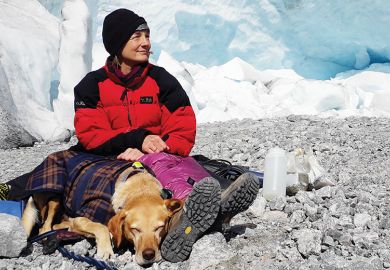Stephen Jay Gould's success, as everybody knows and he himself expounds in the preface to The Lying Stones of Marrakech , is down to the bibliographic nature of his essays, honed to near-perfection over the years by his unnaturally punctual monthly submissions to the journal Natural History . Gould has spent years researching and trying to understand and place in historical context the motives of some of the most influential natural scientists ever. In doing so, he transcends mere categorisation of facts and exposes the guiding idea or ideal of the subject.
The Lying Stones of Marrakech roams widely in theme and time, from Galileo and secret societies to urban legends and Dolly the sheep. It takes its title from The Lying Stones of Dr Beringer , an account concerning the ill-fated Professor Beringer of Würzburg who, set up by his students and jealous colleagues, published a document describing a series of remarkable fossils including spiders' webs, copulating frogs and comets complete with tails. Most extraordinary were the Hebrew letters "YHVH", spelling out the tetragrammaton. This is, of course, ludicrous, and when realisation dawned that he had been duped, Beringer retired a broken man. Or so convention says.
Gould (more than once) sets the record straight, exposing, by digging deeper, the truth behind those risible individuals whose alleged demeanours make them appear ridiculous today. Context is crucial - assumptions and interpretations of phenomena made by earlier generations of natural scientists may sound fanciful and, on occasion, downright hilarious to modern practitioners, but we are looking back and judging them against our own understanding and superior knowledge base. For example, in Beringer's day, it was believed, following Aristotle, that organisms could arise by spontaneous generation from the inorganic mineral world. Such reasoning is exemplified in the work of Francesco Stelluti, a member of the Academy of Lynxes, Europe's oldest scientific society, founded in 1603, whose treatise on the origin of fossil wood describes its transmutation from clay to plant. To be fair, Stelluti, then Beringer, were guilty only of describing what they had observed. But observations are never value-free, and there is real danger in playing personal observation as the trump card in disputes over natural processes. Even the great Galileo (a Lynx himself) fell foul when he misinterpreted the rings of Saturn and declared the planet to be three-bodied. Two things come from this. First, Gould can rightly claim to be the patron saint of the risible scientist, exposing lazy propagation of factual inconsistencies and restoring a rightful balance to tarnished reputations. The second is more sobering - there publish among us, unknowingly, some who will be remembered by future generations as latter-day Beringers and Stellutis.
Gould excels in bringing to life the significance of something the rest of us would consider mundane, such as map margins. Stratigraphic sections alongside geological maps are taken for granted, but it took the genius of Lavoisier to place them there and in doing so, to extend a flat sheet into the third dimension.
Not surprisingly in a book dealing with profound intellectual accomplishments, the theme of scientific greatness crops up more than once. Darwin (Gould's hero) was surprised by his own success, but would his work have had the same impact had it been published a century earlier? Greatness requires more that just achieved brilliance; timing and luck are crucial ingredients. Reading each piece here in turn gives an impression of the scientific community of 18th and 19th-century Europe as a close-knit thing, with publication by eminent men of works on a variety of topics commonplace. For example, Charles Babbage, better known as the forefather of the computer than champion of Lyell's uniformitarianism, wrote a number of papers on the subject of geology, including a discourse on the famous Pillars at Pozzuoli, and a far-fetched account (inspired by Darwin) claiming the craters on the moon to be remnant coral atolls.
The essay on J. B. S. Haldane, father of modern evolutionary biology, is perhaps the most shocking. Haldane (described by Peter Medawar as the cleverest man he had known) conducted experiments on himself into the effects of gas poisoning. His account of exposure to firedamp while reciting aloud to his father Mark Antony's speech from Julius Caesar ("I soon began to pant, and somewhere about 'the noble Brutus' my legs gave way") is pure Monty Python. Haldane's work, selfless and crucial in developing gas-mask technology, undoubtedly saved lives. But its culmination, a book promoting the use of chemical weapons in warfare on humanitarian grounds, is rather less zany. My grandfather, although blinded temporarily, survived two gas attacks at Ypres. Some of the lads were not so lucky.
Gould also comments on the workings of professional scientists and its reportage in the print media, cautioning against the lure of reductionism and the temptation among practising scientists to extrapolate single observations into generalities. He also ridicules sensationalist headline journalism: "'Scientists say we use just 10 per cent of our brains' (really? then what is the other 90 per cent doing?)." This leads to a wider issue relating to the popularisation of science. Some of literature's most noble have lined up at one time or another to praise Gould, the acknowledged master of the genre. These individuals are an informed, educated, elite public, and while Gould is not quite preaching to the converted (there remain those in the arts who are openly hostile to science), none would question that acquiring knowledge for its own sake needs no further justification. But beyond the segmented demographics of the marketing department's educated laymen, lies a much larger public, unfamiliar with the cosy world of the footnote and classical reference. Despite the brilliance of Gould and other popularisers, if he wrote a weekly science column in The National Enquirer or The Sun he would do more to raise awareness (but not necessarily understanding) of the importance of science in everyday life than all the clever essays in all the glossy jackets in all the bookclubs of the world.
Nick Petford is senior lecturer in geology, Kingston University.
The Lying Stones of Marrakech
Author - Stephen Jay Gould
ISBN - 0 224 05044 3
Publisher - Cape
Price - £17.99
Pages - 372
Register to continue
Why register?
- Registration is free and only takes a moment
- Once registered, you can read 3 articles a month
- Sign up for our newsletter
Subscribe
Or subscribe for unlimited access to:
- Unlimited access to news, views, insights & reviews
- Digital editions
- Digital access to THE’s university and college rankings analysis
Already registered or a current subscriber?



